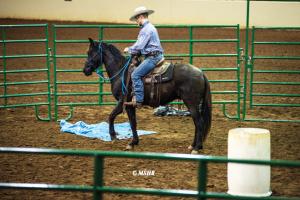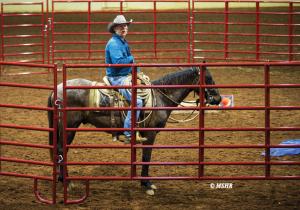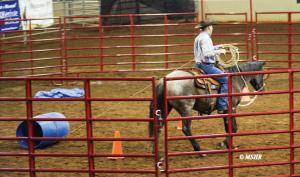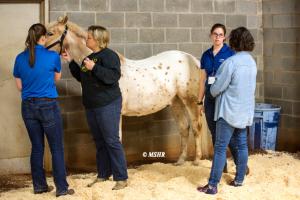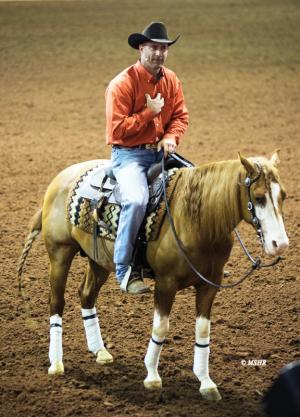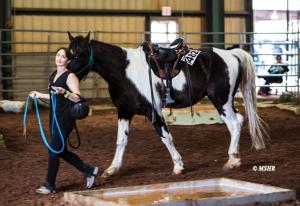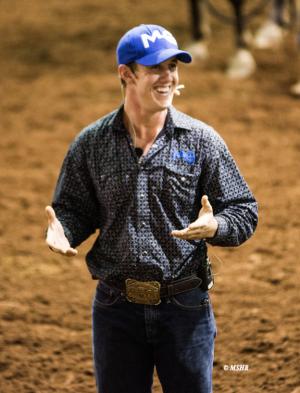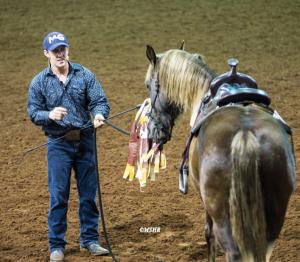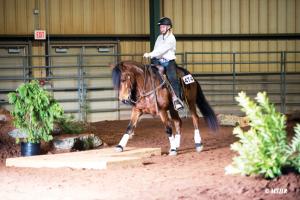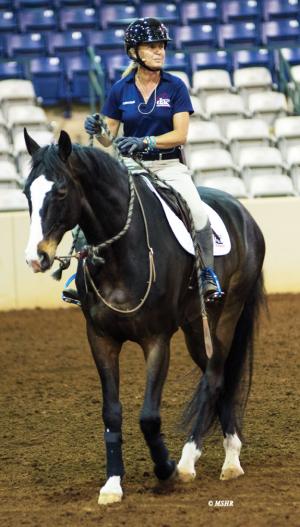By Kristi Crowe
On the weekend of February 23-25, 2018 the Tennessee Miller Coliseum was alive with horse people of all kinds attending the seventh annual Southern Equine Expo. The highlight of the Expo was a variety of clinics put on by an impressive variety of nationally renowned horsemen. There were also a number of horse breeds on display, ranging from Minis to Clydesdales. And, of course, attendees of the Southern Equine Expo could shop all kinds of horse-related products from many vendors in one location.
Patrick Kayser, the event manager and President of Peak Equine Productions, LLC, started the Southern Equine Expo six years ago to fill a gap in the “expo market.” There were no horse expos north of Interstate 20 and south of Kentucky. Patrick started the Southern Equine Expo to serve Georgia, Tennessee, Alabama, Mississippi and Kentucky, and to provide quality presentations and vendors. The main goal is to bring horse people of all disciplines together, from show riders to backyard horse enthusiasts. This year, participants came from as far away as Michigan and Canada. The event has grown so much since its founding that, now, some vendors and clinicians have to be turned away due to lack of space.
The Smoky Mountain Trail Challenge, a course built with natural obstacles found while trail riding, is a signature event of the Expo. This is open to all riders of any discipline. So, Michael Gascon’s clinic on crossing obstacles was a benefit for participants in the trail challenge. There were three rounds in the trail challenge, with the top five coming to the third, final round.
The Expo used all available space inside the coliseum. In one corner by the East Arena and the Peak Arena, there was a section for small lectures and demonstrations. Here one could learn how to measure Temperature, Pulse and Respiration (TPR) in your horse. One could also learn how horses, mules and donkeys think differently from each other. They are all equines, but their thought patterns are as different as their looks. There were also demonstrations on proper saddle fitting, side saddle basics, and hay analysis.
In the Colt Starting Challenge trainers demonstrate how horsemanship and relationship building are pertinent to building a working partnership with a horse. There are five sessions to the challenge, and it is not a race to see who can get their colt going first. Rather, the emphasis is on the path taken to achieve the partnership. The first three sessions are in the round pen, where the trainers build the trust and base needed to begin basic training of the horse. The fourth session is work on longeing and long line driving to help the horse further understand the work started in the round pen. The final session is an obstacle course.
The horses used were provided by Lost Creek Cattle Company. They were three-year-old geldings who were halter broke, but minimally handled and not saddled. The three contestants were randomly assigned a horse and the work began. This year’s Colt Starting contestants were: Stephen Graycheck, Cliff Schadt, Jr., and Perry Neal. Cliff Schadt emphasized the importace of having your seat engaged to keep forward motion of the horse. Perry Neal was cantering his horse in the third session and swinging a lasso. Stephen Graycheck had a very forward horse. This year’s Colt Starting Challenge winner was Perry Neal, with second place going to Cliff Schadt, Jr., and third to Stephen Greycheck.
Clinicians at this year’s Expo included Josh Lyons, Brandi Lyons, Michael Gascon, Candice King, Michael Lyons, Cedar Ports-Warner, Steve Edwards, Elizabeth Clavette, Elizabeth Tinnan, Sam Powell, and Josh Peebles.
Clinician Josh Lyons emphasized that the most powerful tool you have when working with your horse is the pressure – release system that works with the horse using his own language. The horse knows he has done the right thing when the pressure is released. This was a theme in his clinics: “Best Ground Exercises for Riding” and “Whoa Dang It!” Have you ever wondered why a horse will overreact when you swat a fly on its rump, but will shrug off a kick from a pasture mate? The horse knows what the other horse is capable of, but not what you are capable of. Josh says you should have improvement days and maintenance days when working your horse. Some days you work on improving your horse’s training. Other days, just maintain what the horse already knows. This process helps keep the horse fresh and receptive.
In his clinics “How To Get Your Horse Willing To Cross Obstacles” and “How To Gain Confidence And Get Control Of Your Horse,” Michael Gascon asked, “What is the best and first thing to prepare a horse for trail riding?” The answer is respect and undivided attention. “Train the horse you want him to be,” Michael told the audience. “If you act careful around a horse, you are creating a horse you have to act careful around.” Other highlights from Michael’s presentation: Always start your horse in a round pen to establish absolute control. The horse must perceive the human to be the alpha. If you control the head, you control the horse. When a horse moves out of the handler’s space, he is giving respect. If you have a reactive horse, you didn’t ask the right question. It is easier to train a horse from the beginning, fresh, than to re-train a horse that has had a difficult start.
Michael says there are three levels of horses. (1) The horse that doesn’t behave for anyone, even the owner, comes from bad training. (2) The horse that is all right with his owner, but not trustworthy with others, comes from OK training. (3) The horse that is good for everybody comes from great training. Michael.
Michael’s “How To Get Your Horse Willing To Cross Obstacles” clinic utilized a volunteer, Noëll and her Spotted Saddle Horse, Mr. Moses. Noëll had been riding for only eight months and enjoyed the clinic. Michael explained that when introducing challenges to your horse in ground training, start with the nose; that is the way horses check things out. If your horse balks when approaching an obstacle while under saddle, do not turn your horse away from the obstacle. Keep pushing your horse to go through the obstacle.
For example, if you have a hard time getting your horse through water, it may be your body language telling the horse the water is dangerous! The horse naturally puts its head down to look at the water; but the rider may be afraid the horse will jump, so pulls on the reins. This tells the horse to stop and not go near the water. Sometimes our actions can tell the horse the opposite of what we want the horse to do. Using finesse to cross an obstacle can be easier when the obstacle is bigger. Think of trying to get your horse through a small puddle, as opposed to across a creek. The puddle can be avoided, but the creek cannot. Other trail challenge obstacles are called Push Through obstacles, similar to noodles hanging down like in a car wash, where you just push the horse through.
Candice King, a Grand Prix Show Jumping rider, had good information in the “Less Is More” clinic. In her own career, she started with the difficult horses that others couldn’t ride. Her family didn’t have the money required to put a rider through the ranks to the top, so she took it upon herself and became a working student. As a student, she was fortunate to accompany her trainer, with a other working students, to Europe for a few weeks each summer, where they travelled to Germany, Denmark and the Netherlands. She learned over the years that a horseman is always learning, and there are different ways to achieve results.
Candice emphasized that it is important to keep your horse engaged. The rider and horse should be partners.
When riding your horse, it is important to not micromanage. The horse will get frustrated if you are always making small corrections. Horses can get burned out quickly if they are constantly being told how to perform their job.
Working around obstructions in the area where you are riding will give your horse a simple job. This helps keep their attention with you the rider. Use voice aids so you don’t have to completely rely on using your hand and leg aids.
Candice also uses the pressure-release method. For example, if your horse is anxious and not listening to you well, walk your horse at an easy, slow speed. Bend your horse around your inside leg, with no outside rein or leg, and relax your seat. When the horse relaxes, stop, give rein and relax. This teaches the horse it is better to relax, because the pressure will be released. Equally important is that bending the horse doesn’t mean that forward momentum is lost.
When a horse gets on the forehand, they can get strong and intense. A spectator at Candice’s clinic asked how to get her horse off the forehand and listen to her better. She rides her horse in a bitless bridle. Candice asked if she wore spurs. While some people may believe spurs are just a gadget, or a harsh aid, when used correctly they are an important and effective training aid. Spurs give more strength to your leg so the horse can understand the cues better. Without spurs, you have to use more leg pressure. Then the horse learns that he doesn’t have to listen and leans into you. That is not a way to promote a partnership.
There was so much more to learn and experience at this year’s Southern Equine Expo. Patrick plans for the Southern Equine Expo to be held again at the Tennessee Miller Coliseum the last weekend in February 2019. For more information about this year’s Expo, visit www.southernequineexpo.comand on facebook at: Southern Equine Expo.
I would like to thank Suzanne Russom for assisting and taking great notes for me.
On the weekend of February 23-25, 2018 the Tennessee Miller Coliseum was alive with horse people of all kinds attending the seventh annual Southern Equine Expo. The highlight of the Expo was a variety of clinics put on by an impressive variety of nationally renowned horsemen. There were also a number of horse breeds on display, ranging from Minis to Clydesdales. And, of course, attendees of the Southern Equine Expo could shop all kinds of horse-related products from many vendors in one location.
Patrick Kayser, the event manager and President of Peak Equine Productions, LLC, started the Southern Equine Expo six years ago to fill a gap in the “expo market.” There were no horse expos north of Interstate 20 and south of Kentucky. Patrick started the Southern Equine Expo to serve Georgia, Tennessee, Alabama, Mississippi and Kentucky, and to provide quality presentations and vendors. The main goal is to bring horse people of all disciplines together, from show riders to backyard horse enthusiasts. This year, participants came from as far away as Michigan and Canada. The event has grown so much since its founding that, now, some vendors and clinicians have to be turned away due to lack of space.
The Smoky Mountain Trail Challenge, a course built with natural obstacles found while trail riding, is a signature event of the Expo. This is open to all riders of any discipline. So, Michael Gascon’s clinic on crossing obstacles was a benefit for participants in the trail challenge. There were three rounds in the trail challenge, with the top five coming to the third, final round.
The Expo used all available space inside the coliseum. In one corner by the East Arena and the Peak Arena, there was a section for small lectures and demonstrations. Here one could learn how to measure Temperature, Pulse and Respiration (TPR) in your horse. One could also learn how horses, mules and donkeys think differently from each other. They are all equines, but their thought patterns are as different as their looks. There were also demonstrations on proper saddle fitting, side saddle basics, and hay analysis.
In the Colt Starting Challenge trainers demonstrate how horsemanship and relationship building are pertinent to building a working partnership with a horse. There are five sessions to the challenge, and it is not a race to see who can get their colt going first. Rather, the emphasis is on the path taken to achieve the partnership. The first three sessions are in the round pen, where the trainers build the trust and base needed to begin basic training of the horse. The fourth session is work on longeing and long line driving to help the horse further understand the work started in the round pen. The final session is an obstacle course.
The horses used were provided by Lost Creek Cattle Company. They were three-year-old geldings who were halter broke, but minimally handled and not saddled. The three contestants were randomly assigned a horse and the work began. This year’s Colt Starting contestants were: Stephen Graycheck, Cliff Schadt, Jr., and Perry Neal. Cliff Schadt emphasized the importace of having your seat engaged to keep forward motion of the horse. Perry Neal was cantering his horse in the third session and swinging a lasso. Stephen Graycheck had a very forward horse. This year’s Colt Starting Challenge winner was Perry Neal, with second place going to Cliff Schadt, Jr., and third to Stephen Greycheck.
Clinicians at this year’s Expo included Josh Lyons, Brandi Lyons, Michael Gascon, Candice King, Michael Lyons, Cedar Ports-Warner, Steve Edwards, Elizabeth Clavette, Elizabeth Tinnan, Sam Powell, and Josh Peebles.
Clinician Josh Lyons emphasized that the most powerful tool you have when working with your horse is the pressure – release system that works with the horse using his own language. The horse knows he has done the right thing when the pressure is released. This was a theme in his clinics: “Best Ground Exercises for Riding” and “Whoa Dang It!” Have you ever wondered why a horse will overreact when you swat a fly on its rump, but will shrug off a kick from a pasture mate? The horse knows what the other horse is capable of, but not what you are capable of. Josh says you should have improvement days and maintenance days when working your horse. Some days you work on improving your horse’s training. Other days, just maintain what the horse already knows. This process helps keep the horse fresh and receptive.
In his clinics “How To Get Your Horse Willing To Cross Obstacles” and “How To Gain Confidence And Get Control Of Your Horse,” Michael Gascon asked, “What is the best and first thing to prepare a horse for trail riding?” The answer is respect and undivided attention. “Train the horse you want him to be,” Michael told the audience. “If you act careful around a horse, you are creating a horse you have to act careful around.” Other highlights from Michael’s presentation: Always start your horse in a round pen to establish absolute control. The horse must perceive the human to be the alpha. If you control the head, you control the horse. When a horse moves out of the handler’s space, he is giving respect. If you have a reactive horse, you didn’t ask the right question. It is easier to train a horse from the beginning, fresh, than to re-train a horse that has had a difficult start.
Michael says there are three levels of horses. (1) The horse that doesn’t behave for anyone, even the owner, comes from bad training. (2) The horse that is all right with his owner, but not trustworthy with others, comes from OK training. (3) The horse that is good for everybody comes from great training. Michael.
Michael’s “How To Get Your Horse Willing To Cross Obstacles” clinic utilized a volunteer, Noëll and her Spotted Saddle Horse, Mr. Moses. Noëll had been riding for only eight months and enjoyed the clinic. Michael explained that when introducing challenges to your horse in ground training, start with the nose; that is the way horses check things out. If your horse balks when approaching an obstacle while under saddle, do not turn your horse away from the obstacle. Keep pushing your horse to go through the obstacle.
For example, if you have a hard time getting your horse through water, it may be your body language telling the horse the water is dangerous! The horse naturally puts its head down to look at the water; but the rider may be afraid the horse will jump, so pulls on the reins. This tells the horse to stop and not go near the water. Sometimes our actions can tell the horse the opposite of what we want the horse to do. Using finesse to cross an obstacle can be easier when the obstacle is bigger. Think of trying to get your horse through a small puddle, as opposed to across a creek. The puddle can be avoided, but the creek cannot. Other trail challenge obstacles are called Push Through obstacles, similar to noodles hanging down like in a car wash, where you just push the horse through.
Candice King, a Grand Prix Show Jumping rider, had good information in the “Less Is More” clinic. In her own career, she started with the difficult horses that others couldn’t ride. Her family didn’t have the money required to put a rider through the ranks to the top, so she took it upon herself and became a working student. As a student, she was fortunate to accompany her trainer, with a other working students, to Europe for a few weeks each summer, where they travelled to Germany, Denmark and the Netherlands. She learned over the years that a horseman is always learning, and there are different ways to achieve results.
Candice emphasized that it is important to keep your horse engaged. The rider and horse should be partners.
When riding your horse, it is important to not micromanage. The horse will get frustrated if you are always making small corrections. Horses can get burned out quickly if they are constantly being told how to perform their job.
Working around obstructions in the area where you are riding will give your horse a simple job. This helps keep their attention with you the rider. Use voice aids so you don’t have to completely rely on using your hand and leg aids.
Candice also uses the pressure-release method. For example, if your horse is anxious and not listening to you well, walk your horse at an easy, slow speed. Bend your horse around your inside leg, with no outside rein or leg, and relax your seat. When the horse relaxes, stop, give rein and relax. This teaches the horse it is better to relax, because the pressure will be released. Equally important is that bending the horse doesn’t mean that forward momentum is lost.
When a horse gets on the forehand, they can get strong and intense. A spectator at Candice’s clinic asked how to get her horse off the forehand and listen to her better. She rides her horse in a bitless bridle. Candice asked if she wore spurs. While some people may believe spurs are just a gadget, or a harsh aid, when used correctly they are an important and effective training aid. Spurs give more strength to your leg so the horse can understand the cues better. Without spurs, you have to use more leg pressure. Then the horse learns that he doesn’t have to listen and leans into you. That is not a way to promote a partnership.
There was so much more to learn and experience at this year’s Southern Equine Expo. Patrick plans for the Southern Equine Expo to be held again at the Tennessee Miller Coliseum the last weekend in February 2019. For more information about this year’s Expo, visit www.southernequineexpo.comand on facebook at: Southern Equine Expo.
I would like to thank Suzanne Russom for assisting and taking great notes for me.
